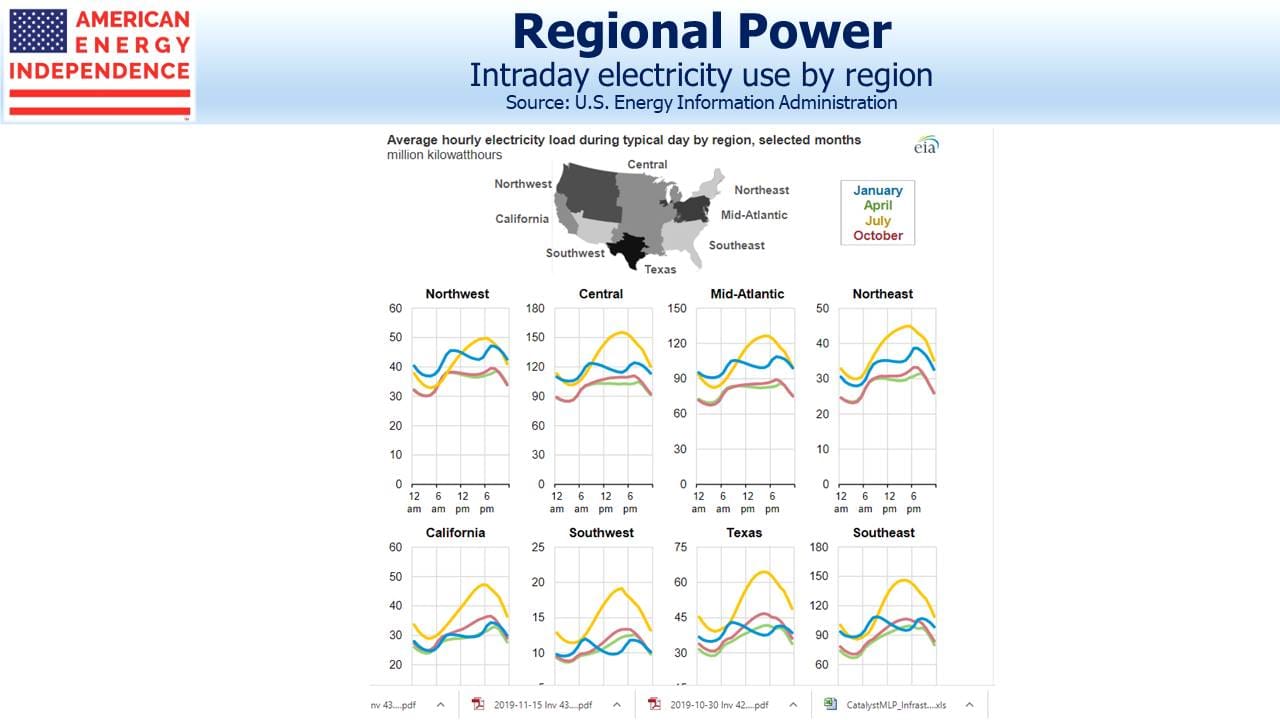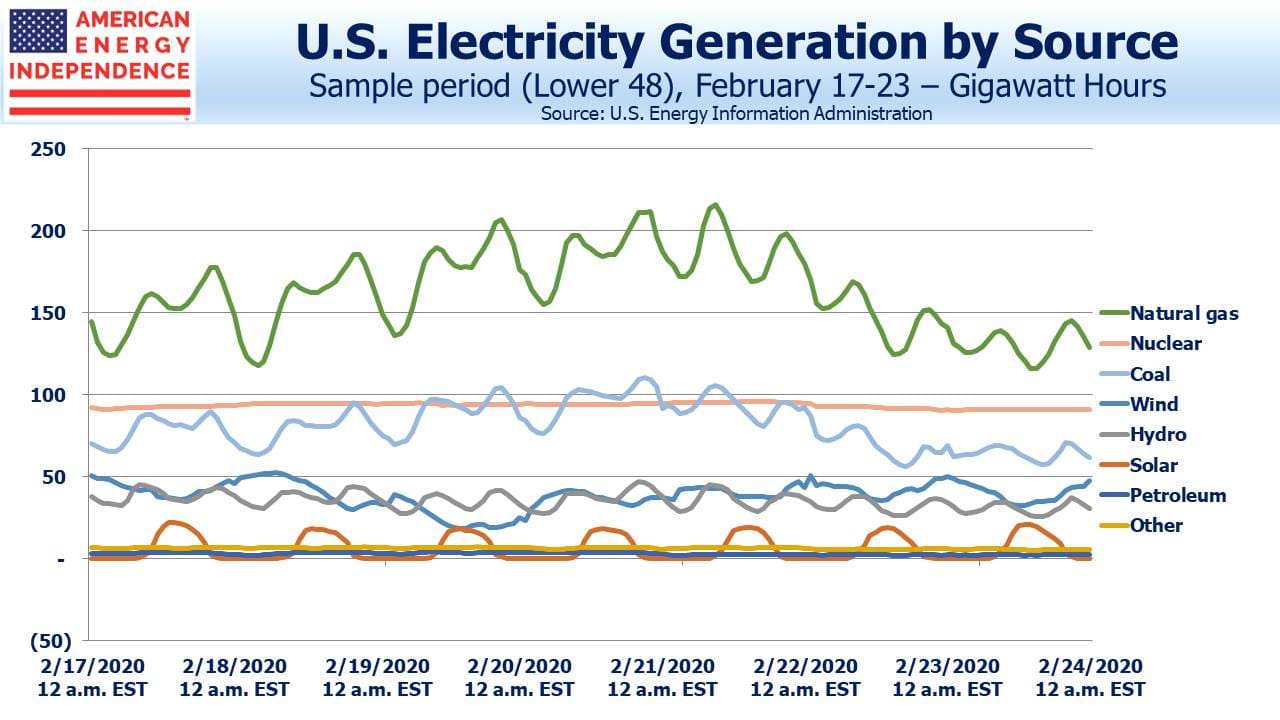Where America Gets its Power
One of the challenges facing solar energy in providing electricity is that demand often peaks at the beginning and end of the workday. When people are preparing to head to work or school, electricity demand rises. The second peak occurs during early evening during dinner. Solar output peaks around midday, inconveniently between the twin household peaks.
The Energy Information Administration (EIA) produces more detailed data on electricity consumption that shows intra-day consumption by region and at different times during the year. It presents a much richer picture of how we use electricity.
The twin peaks around breakfast and dinner apply most clearly during winter. There are clear regional differences too. In the southwest, consumption during the day is barely above nighttime, which is normally the trough in all cases. In the northeast and Pacific coast, evening demand is higher than morning, while in Texas and the southeast the reverse is true. It’s probably driven by relatively fewer hours of daylight in northern latitudes, but perhaps Texans watch more morning TV as well.
In summer, the need for air conditioning dominates, and intra-day electricity consumption is highest around mid-afternoon in every region, which aligns more conveniently with solar output. As a result, demand is highest in the summer, with spring and fall being lowest.
You can also see how we source our electricity on an hourly basis. The chart takes a recent seven-day period. Solar and wind are intermittent, so they produce when they can. Natural gas and to a lesser extent coal produce when they’re needed, which highlights a huge advantage fossil fuels have over renewables. Often the intra-day peak for natural gas is when renewables generation is low. Coal burning power plants are less able than natural gas plants to change output easily in response to shifts in demand. Over the sample period, natural gas output had a -0.40 correlation with wind, neatly capturing the symbiotic relationship that exists between the two. As a grid increases its reliance on renewables, fluctuations in output must be balanced either with battery storage or natural gas. Nuclear output is steady, making it a poor renewables partner, although an energy policy focused on reduced emissions would favor increased nuclear power.
Although renewables receive substantial press coverage, solar provided only 1.5% of our electricity in mid-February. Wind has been more successful, at 9.1%. But the big change in mix has been the steady displacement of coal by natural gas, which drove America’s 2.5% drop in CO2 emissions last year. Natural gas burns cleaner and runs when it’s not sunny or windy. It’s part of our energy future.
Important Disclosures
The information provided is for informational purposes only and investors should determine for themselves whether a particular service, security or product is suitable for their investment needs. The information contained herein is not complete, may not be current, is subject to change, and is subject to, and qualified in its entirety by, the more complete disclosures, risk factors and other terms that are contained in the disclosure, prospectus, and offering. Certain information herein has been obtained from third party sources and, although believed to be reliable, has not been independently verified and its accuracy or completeness cannot be guaranteed. No representation is made with respect to the accuracy, completeness or timeliness of this information. Nothing provided on this site constitutes tax advice. Individuals should seek the advice of their own tax advisor for specific information regarding tax consequences of investments. Investments in securities entail risk and are not suitable for all investors. This site is not a recommendation nor an offer to sell (or solicitation of an offer to buy) securities in the United States or in any other jurisdiction.
References to indexes and benchmarks are hypothetical illustrations of aggregate returns and do not reflect the performance of any actual investment. Investors cannot invest in an index and do not reflect the deduction of the advisor’s fees or other trading expenses. There can be no assurance that current investments will be profitable. Actual realized returns will depend on, among other factors, the value of assets and market conditions at the time of disposition, any related transaction costs, and the timing of the purchase. Indexes and benchmarks may not directly correlate or only partially relate to portfolios managed by SL Advisors as they have different underlying investments and may use different strategies or have different objectives than portfolios managed by SL Advisors (e.g. The Alerian index is a group MLP securities in the oil and gas industries. Portfolios may not include the same investments that are included in the Alerian Index. The S & P Index does not directly relate to investment strategies managed by SL Advisers.)
This site may contain forward-looking statements relating to the objectives, opportunities, and the future performance of the U.S. market generally. Forward-looking statements may be identified by the use of such words as; “believe,” “expect,” “anticipate,” “should,” “planned,” “estimated,” “potential” and other similar terms. Examples of forward-looking statements include, but are not limited to, estimates with respect to financial condition, results of operations, and success or lack of success of any particular investment strategy. All are subject to various factors, including, but not limited to general and local economic conditions, changing levels of competition within certain industries and markets, changes in interest rates, changes in legislation or regulation, and other economic, competitive, governmental, regulatory and technological factors affecting a portfolio’s operations that could cause actual results to differ materially from projected results. Such statements are forward-looking in nature and involves a number of known and unknown risks, uncertainties and other factors, and accordingly, actual results may differ materially from those reflected or contemplated in such forward-looking statements. Prospective investors are cautioned not to place undue reliance on any forward-looking statements or examples. None of SL Advisors LLC or any of its affiliates or principals nor any other individual or entity assumes any obligation to update any forward-looking statements as a result of new information, subsequent events or any other circumstances. All statements made herein speak only as of the date that they were made. r
Certain hyperlinks or referenced websites on the Site, if any, are for your convenience and forward you to third parties’ websites, which generally are recognized by their top level domain name. Any descriptions of, references to, or links to other products, publications or services does not constitute an endorsement, authorization, sponsorship by or affiliation with SL Advisors LLC with respect to any linked site or its sponsor, unless expressly stated by SL Advisors LLC. Any such information, products or sites have not necessarily been reviewed by SL Advisors LLC and are provided or maintained by third parties over whom SL Advisors LLC exercise no control. SL Advisors LLC expressly disclaim any responsibility for the content, the accuracy of the information, and/or quality of products or services provided by or advertised on these third-party sites.
All investment strategies have the potential for profit or loss. Different types of investments involve varying degrees of risk, and there can be no assurance that any specific investment will be suitable or profitable for a client’s investment portfolio.
Past performance of the American Energy Independence Index is not indicative of future returns.





Leave a Reply
Want to join the discussion?Feel free to contribute!